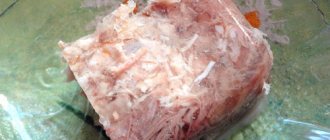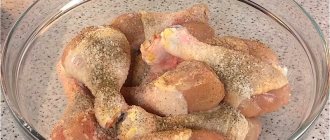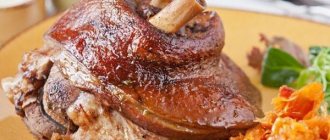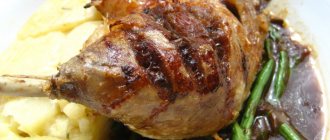How do you get jellied meat?
Jellied meat is a dish that has a thick consistency formed from broth. The classic cooking method does not involve the use of gelatin or agar-agar for hardening. Therefore, in this version, jellied meat cannot be called aspic. But modern housewives actively use thickeners as a “safety net.”
Pork leg jellied meat is obtained due to the presence of gelling substances in the pork bones, which are boiled down during the cooking process and harden when cooled. For the best effect, it is recommended to cut the bones, so access to the substance will be open.
Every housewife should know that jellied meat is a high-calorie dish, the excessive consumption of which can lead to diseases of the blood vessels.
Pork legs in beer
Pork legs in beer, a dish known since the time of the king of peas, comes from the Baltic states. During Soviet times, this recipe was offered as national cuisine (along with pig ears) in Baltic restaurants. To prepare 5 servings you need:
- 4 pork feet
- 1 liter of light beer (wheat can be used)
- teaspoon black pepper
- 1 red hot pepper
- Bay leaf
- tablespoon salt
To get started:
- We take the pork legs, wash them, pour them over with boiling water, wipe them dry, our task is to see all the defects in the industrial processing of the product, namely the remains of bristles, the keratinized parts of the hooves that have not been removed.
- We begin to resin, you can do this simply over a gas stove, but it is better with a special gas burner. And so, we burn the legs to a dark brown color, carefully going through the places with remnants of bristles. We pay special attention to the places between the two big toes (the inter-claw gap) and the keratinized layer of the hooves; they can be burned almost black.
- Once again, thoroughly pour boiling water over the entire leg.
- Insist (cover with a cloth soaked in hot water for 4-8 minutes).
- We clean, scrape with a sharp knife in the direction of the cut from the hoof, thoroughly clean between the toes, and cut off the keratinized protrusions. Wash thoroughly again. The result should be a light yellow hoof, unless the pig was black, without bristles and keratinized plates.
- We wipe dry, inspect, and clean poorly treated areas again. If handled poorly during the cooking process, the bristles will come out of the skin and there is a chance to taste the unshaved legs of the pig.
Cooking pork legs in beer:
- We put more in the pan, since at first, during heat treatment, the hooves will be elastic and begin to crawl out of the container.
- Pour light beer so that the liquid covers them completely. If you need to make the taste less intense, the beer can be diluted with water in different proportions.
- Add spices: black pepper, red pepper pod, bay leaf.
- We salt it heavily. We don’t skimp on salt and spices because the beer will partially take over the strength of the broth and the legs may turn out bland.
- Place on low heat, cook for 4 to 6 hours, like jellied meat, until the bones begin to separate (if in a pressure cooker, then for 2 hours).
Serve the dish hot, remove with a slotted spoon and place on a large plate. Canned green peas are a good side dish. The legs go very well with cold dark beer.
Share link:
Benefits of the dish
Many families prefer to see jellied meat at feasts according to established tradition. But not everyone knows about its usefulness. One of the main advantages of the dish is the presence of collagen in it - a building protein for every cell of the body.
In addition to collagen, jellied meat is rich in the following elements:
- Vitamins (especially group B) have a positive effect on the formation of hemoglobin.
- Lysine is a special acid that affects the better absorption of calcium and helps in the fight against viruses.
- Fatty acids - calm the human nervous system.
- Glycine – is responsible for activating brain function, reducing irritability and fatigue.
- Gelatin – helps improve joint function.
Housewives decide in advance how to prepare jellied pork legs: with or without the addition of gelatin. The aspic looks extremely piquant. To give the dish a festive look, you can decorate it with herbs.
Jellied pork and chicken: recipe
There are many recipes for making jellied meat. Consider a cooking recipe that includes chicken. To prevent jellied pork from being too fatty, many housewives add poultry to the composition. Thus, the amount of meat in the jellied meat is preserved and the fat content is reduced.
It is recommended to choose a rooster for cooking. Then the broth will become rich and will have a special aroma. The key to success is to choose only fresh meat, chilled but not frozen. How and how much to cook jellied pork legs and chicken? This process is lengthy and takes approximately 5-6 hours. The main feature is the complete separation of pork meat from the bones.
Ingredients for cooking:
- 2 pork legs;
- 1 chicken;
- 1 carrot (more is possible, leave boiled for decoration);
- bulb;
- a piece of pork weighing 500 grams;
- bay leaf 1 piece;
- salt and pepper - according to taste preferences.
These ingredients will be enough to prepare ten plates of delicious jellied meat.
Jellied pork legs and chicken: homemade recipe
If you use chicken meat in addition to pork legs to cook jellied meat, this will not only make the dish cheaper, but also get a more tender appetizer. Chicken meat will play an excellent role in this; the snack will become more dietary. It's no secret that jelly made from cold cuts is especially successful.
Ingredients:
- Before cooking, pork legs should first be soaked for an hour in 2-3 waters, then cleaned with a knife, and the bristles should be set on fire over the burner. Place meat and chicken in a large saucepan.
If the whole bird does not fit, divide it into parts.
- Fill the meat with water and put it on fire. As the foam forms, remove it with a slotted spoon. Then place the prepared vegetables – onions and carrots – into the pan.
- Cook the dish for several hours over low heat with the lid closed until the meat begins to separate from the bone. At the end of cooking, half an hour before the end, add bay leaf, spices and salt.
The cooking time for our jellied meat was about 4 hours.
- Then remove the meat from the broth and separate it into fibers.
- Strain the broth through a sieve or gauze folded several times.
- Place the meat on the bottom of the pan in an even layer, squeeze out the garlic cloves.
- Pour clear broth on top. Let the dish cool to room temperature first.
- Then put it in the refrigerator to completely harden for 5-6 hours.
Cut the finished appetizer into portions and serve with horseradish or mustard. Bon appetit!
Pork feet and beef
The recipe recommends taking a pork leg or drumstick with skin and adding a leg of beef to it. Then the pork and beef jellied meat will freeze well. If you use only beef pulp, the results may be disappointing. The only solution is to use gelatin.
Ingredients required for cooking:
- pork legs - 4 pieces;
- beef tenderloin.
You will also need vegetables:
- carrots - 3 pieces;
- celery;
- bulbs - 2 pieces.
Spices:
- bay leaf - 6 pieces;
- black peppercorns - to taste.
The cooking time is also about 6 hours. The older the meat, the longer it needs to be boiled. For example, middle-aged tough beef should be cooked for 7-8 hours.
How to properly cook jellied pork legs and knuckles in a slow cooker
Nowadays, you can’t live without a multicooker. Many housewives appreciated the convenience of this kitchen assistant and now refuse to prepare food in the traditional way. Let’s not lag behind the times, and now I’ll tell you how to cook pork jellied meat in a slow cooker.
Ingredients:
- After soaking in cold water (at least an hour), remove dirt from the pork legs with a knife.
- Peel the carrots and onions and cut them into circles.
- Place the shanks and chopped vegetables into the multicooker bowl. Season with your favorite spices and salt. Fill the contents of the bowl with water to the maximum about class=”aligncenter” width=”600″ height=”383″[/img]
- Having closed the device with a lid, set the “Quenching” mode for 5-6 hours.
- Upon completion of the program, remove the bowl from the multicooker and remove the meat and vegetables from the broth. Strain the broth through a sieve.
- Separating the cooled meat from the bones, cut it into small pieces.
- Let's prepare the garlic - peel the cloves and chop them very finely.
You can also pass the garlic through a press.
- Place the meat in clean and dry molds and add garlic to taste on top. Pour in hot broth and, after cooling to room temperature, place in the refrigerator to completely gel.
An amazingly tasty and aromatic snack is ready! Call everyone to the table!
Jellied pork legs and knuckles: recipe
Typically, this recipe is based on only pork legs and knuckle.
You will need the following ingredients:
- drumstick and leg - 1 piece each;
- black peppercorns – 8 pieces;
- garlic – 1 small head or 4 large cloves;
- salt - ½ teaspoon or as desired by the hostess.
The process of preparing jellied meat is almost the same for all recipes. Only the time is different. This type of dish should be cooked for 5-6 hours, leaving the lid closed.
Jellied pork feet
Pork leg jellied meat is an excellent appetizer that is rightfully very popular on the holiday table, especially on New Year, Christmas and Epiphany. Jellied meat, or jelly, is a dish of pieces of meat in meat broth, which, when cooled, acquires a jelly-like consistency.
The history of preparing jelly goes back to the distant 16th century, and therefore many different recipe variations for its preparation have accumulated. We present to your attention one of the most successful ways of preparing it with the addition of chicken meat and strongly recommend that you try it.
Time - 5-6 hours. Servings - 4 boats.
Products
- pork legs - 3 pcs.;
- chicken - ½ part;
- onion - 1 pc.;
- carrots - 1 pc.;
- garlic - 1-2 cloves;
- salt - to taste.
Preparation
1. I always add pork legs to jellied meat. By putting them in a pan, I can be absolutely sure that the dish will harden even without adding gelatin. It is this property, by the way, that distinguishes jelly from aspic, which turns into jelly only after adding gelatin and similar thickeners.
2. I wash the tarred pork legs under running (cold) water, carefully cleaning and scraping them with a knife. I do this the night before and then put it in a bowl of cold water and place it in a cool place overnight. In the morning, I cut the legs in half, wash them and put them in a bowl of clean water for another half hour. 3. It’s good to add chicken or rooster meat to the jellied meat. I put in homemade chicken, or rather half of it, since I didn’t plan to cook a lot of jelly. I thoroughly wash the chicken meat under running (cold) water and place it in water near the legs so that any remaining blood comes out. 4. After the blood has come out of the meat, I transfer it from the bowl to a pan, in which I will then cook the jellied meat. I stack the pork leg halves tightly down the pan and place the chicken on top. I fill it with water so that there is a 3-4 cm layer of water above the meat. 5. Place the saucepan on high heat. When the meat broth boils, not entirely pleasant flakes of foam appear on its surface. I remove all the foam with a slotted spoon, and then cover the pan with a lid and reduce the heat to a minimum. I continue to cook on low heat for 5-6 hours. It is important that the broth does not boil too much, otherwise the jellied meat will turn out cloudy. It will be enough if the liquid gurgles slightly. 6. 1.5-2 hours before readiness, add the peeled onion and peeled red carrots. At the same time, add table salt to taste. I usually take 1 tbsp. a spoonful of salt without a slide. 7. Remove the finished jellied meat from the heat and let it settle well. A layer of fat forms on the surface, which I carefully scoop off with a spoon. 8. The finished meat has noticeably fallen off the bone - I take it out of the pan into a separate bowl. 9. Remove the bones from the pork legs and cut them into small pieces. I also separate the chicken meat from the bone, cut it into small (medium-sized) pieces, and place them in a bowl with the pork. 10. Place the chopped meat pulp into bowls. 11. Strain the warm broth through double gauze. Then I add finely chopped garlic to it and mix. I taste the broth and, if necessary, add more garlic or salt. 12. I pour the resulting broth into the containers with meat and place them in a cool place to allow the jellied meat to harden. You can collect the remaining settled fat in the containers on top. 13. Decorate the frozen jellied meat with lemon, parsley and boiled carrots. It is customary to serve horseradish or mustard with the finished dish.
Bon appetit!
receptino.ru
Popular recipes
- Pollock stewed in tomato sauce
- Marinating rabbit and hare meat
- Chicken fillet baked with vegetables and cheese
- Goose baked in the sleeve
- Blue whiting baked in the oven
New recipes
- Buckwheat with fish and mushrooms
- Beef and zucchini cutlets
- Chicken wings in tomato-mayonnaise sauce (in the oven)
- Muffins with minced chicken and sausage cheese
- Smelt stuffed with mozzarella (in the oven)
Cooking correctly: step-by-step instructions
To know how to cook delicious jellied pork legs, you need to carefully read the instructions.
So, the cooking process includes the following steps:
- To cook jellied meat you will need a large deep pan with a capacity of 10-12 liters. Water should be added in a volume of 8 liters, because the jellied meat will cook and boil for a very long time.
- Place the onion in its entirety into the container. There is no need to cut it, as it is needed for the fat. We cut the carrots into three parts and send them to the onion. It is also necessary for fat. After cooking, the vegetables are thrown away along with the bones.
- Place the chicken whole into the pan. There is no need to cut it.
- The pork legs should be cut into three parts and added to the rest of the ingredients. Place the piece of pork into a container without chopping it.
- Place the pan with the food on the fire and cook until the meat begins to separate from the bones. This will take quite a lot of time. But the result will justify the costs. The broth should simmer for at least three to four hours.
- During the cooking process, you need to periodically remove any foam that appears. Otherwise the jellied meat will turn out cloudy.
- 30-40 minutes before the end of cooking, add bay leaf and unground pepper (corns), and twenty minutes before the end, add salt to the broth.
- Next, remove the meat from the broth and place it on a separate dish. Once cooled, remove from bones.
- Strain the broth using a sieve into another pan. This is required so that the jellied meat turns out clean and no small bones get into it. Once all this is done, you can discard the bones and vegetables (carrots and onions). What remains is the meat that was previously chopped and the strained broth.
- Now we move on to pouring the jellied meat.
- It is necessary to prepare clean plates in advance; place pieces of meat in equal quantities on the bottom of them. It is better that each plate contains chicken or beef and pork. Next, fill the dish with broth. It should cover the meat completely.
- After all the jellied meat has been poured into plates, it needs to be transferred to a cold place to cool. In winter you can take it out onto the balcony, and in summer you can put it in the refrigerator.
How to cook jellied meat from pork feet and chicken
I have always really liked the combination of several types of meat in one recipe. At the moment we are combining pork and chicken. The jellied meat tastes simply great. I recommend this option to you.
Ingredients:
- Chicken – 1.8 kg
- Pork legs – 1 kg
- Onion - 1 pc.
- Carrots - 1 pc.
- Garlic – 10 cloves
- Allspice peas - 6 pcs
- Black peppercorns – 10 pcs.
- Bay leaf - 4 pcs
- Salt - to taste
- Water
Preparation:
1. Wash your feet thoroughly and remove any dirt. Rinse the chicken thoroughly too. Soak all the meat in a pan of water for several hours, you can even leave it overnight. Then drain it and rinse the meat under running water.
2. If you have a whole chicken carcass, then divide it into several parts so that it is convenient to put it in a pan. Then, accordingly, place all the meat along with the pork legs in a saucepan and fill it with water so that it covers it completely. Place the pan on the fire. When foam appears, be sure to skim it off.
3. Wait for the broth to boil and reduce the heat to low. From this moment, cook it for 5 hours, periodically removing the foam. You can cover the pan halfway with a lid.
4. After 3.5 hours, place the peeled carrots and onions into the pan. Add salt and continue cooking. 15 minutes before the end, add black pepper and allspice, bay leaf and garlic.
5. Remove the finished meat from the broth, and strain the broth itself through a sieve. Let the meat cool slightly and then remove it from the bones. Break the chicken into small or smaller pieces. Finely chop the meat from the legs.
6. Place it in prepared containers and fill with broth strained through a sieve. Let cool and then place in the refrigerator until completely cool.
7. All we have to do is bring it into a festive look. If you want to remove it from the container, follow my instructions.
Immerse the dish with jellied meat in warm water for 1-2 minutes. Then, using a silicone spatula, carefully separate it from the sides of the dish. Turn the dish over onto a plate and it can easily move there. Decorate and place on the table.
Decoration for jellied meat
Now that the housewife knows how to cook jellied pork legs, the next question that will interest her is how to decorate the dish.
All kinds of delicious vegetables, pickles, and eggs are used for decoration.
Here are some tips:
- You can place decorations either on the bottom of the container with jellied meat or on the meat.
- The dish turns out to be especially beautiful if the correct cooking process is followed and the broth is as clear as possible.
- Boil eggs and carrots, cool and cut into thin slices. You should be careful when handling eggs; the yolks may crumble or fall out.
- Pickled cucumbers and lemon are also cut into thin circles.
- You can also use greens for decoration: dill or parsley.
- To add brightness, red sweet peppers, canned corn, and cranberries are suitable.
- Many housewives try to make flowers from strips of vegetables or cut vegetables into special shapes: hearts, triangles and the like.
What to serve the dish with?
How to prepare jellied meat from pork legs and knuckles, as well as how to decorate it, is described above. Let's figure out how to serve the dish correctly.
Jellied meat can be prepared both in standard dishes - pots, plates, and in unusual ones, for example, muffin tins.
You can serve the finished dish with:
- mustard, which will add a piquant taste;
- horseradish or adjika - for lovers of spicy seasonings;
- sour cream;
- vinegar;
- lemon juice;
- pickles or sauerkraut.
Usually, in addition to jellied meat, vegetable salads are also served on the table, on a separate dish - garlic, green onions and herbs - in addition to jellied meat.
Recipe for pork legs and knuckles
This method allows you to prepare a very dense jellied meat for slicing.
Required Products:
- Several pig's feet.
- Bulb.
- One knuckle.
- Garlic, salt, pepper and seasonings.
Cooking process:
- Place the legs and shanks in water for several hours and let them settle.
- After the allotted time, change the water and let the meat cook for four hours.
- After two hours of cooking, you can add chopped onions and spices.
- After the cooking time is over, remove the meat, cut it into small pieces and mix with garlic. Broth - cool.
- First place a certain amount of meat in the prepared dish, then pour in the broth and leave to cool until completely solidified.
Useful tips for housewives
To know how to cook jellied meat from pork legs, chicken or beef, you should take into account some nuances in preparing the dish.
Some useful tips:
- If you want to decorate the jellied meat with carrots, then towards the end of cooking, add the whole vegetables to the jellied meat. You can then cut out beautiful figures from boiled carrots to decorate the dish.
- If you add salt to the jellied meat in advance, then as the water boils away, it may happen that the saturation of the broth will increase. But if you add salt at the very end, the meat will not have time to soak it in.
- During the entire time that the jellied meat is being cooked, it should not be stirred.
- The shelf life of jellied meat in the refrigerator is two to three days. But the best option would be to eat it on the day of serving.
- What actions should be taken if the jellied meat is not frozen? First of all, don't get upset. All this can be fixed. In order for the jellied meat to thicken, you should pour it into a saucepan and boil for several minutes, then add a little gelatin (according to the instructions).
- You should also remember: the more decorations added to the jellied meat, the shorter its shelf life will be, so you shouldn’t overdo it with decorations.
Jellied pork legs - a classic recipe
This is a standard cooking option without any additions.
Required Products:
- Carrots and onions, one each.
- Salt and other seasonings to taste.
- Four pork feet.
- A few bay leaves.
- Two cloves of garlic.
Cooking process:
- First you need to pour hot water over the legs well, then put them in a large saucepan, add cold water and bring to a boil.
- Prepare vegetables: cut into halves and lightly fry in a dry frying pan on both sides. Then place them in a saucepan with the legs and cook all together for about five hours over low heat.
- Add the bay leaf and other spices to the pan with all the ingredients. After everything boils, boil for about two more hours and remove all the ingredients. Do not pour out the broth.
- Place vegetables in special forms, pour in broth and put in the refrigerator. When the contents thicken, remove the excess fat that has formed on top.
What to replace pork with?
Pork leg jellied meat is healthy, but many people have problems with the gastrointestinal tract, and such a dish becomes a “heavy” product.” Beef is considered a less fatty analogue.
Jellied meat can also be prepared from chicken, fish, rabbit, turkey or game. In these cases, it is necessary to additionally add gelatin, because the gelling components in the bones of these animal species are not enough.
In addition to gelatin, you can use offal: ears, lips, tails or head.
Pork feet dishes
From this meat part you can create a lot of interesting and varied dishes:
- baked knuckle;
- stews, borscht;
- aspic;
- roast;
- ham;
- cold marinated snacks.
All these culinary delights can be prepared not only simply, but also quite quickly! And our selection of simple, proven recipes will help you choose the best of the best!
–Categories
- MEAT AND FISH DISHES (941)
- offal dishes (chicken) (56)
- offal dishes (meat) (50)
- hot chicken (49)
- hot chicken 2 (111)
- hot meat (52)
- hot fish (50)
- hot fish 2 (79)
- herring snacks (43)
- salting fish (32)
- salting lard (23)
- chicken wings (12)
- seafood (32)
- minced meat (51)
- deli meats (49)
- salads and snacks from sausage and ham (53)
- chicken salads and appetizers (77)
- salads and meat snacks (18)
- salads and fish appetizers 2 (15)
- salads and fish appetizers (32)
- tartlets (53)
- DISHES FOR HOLIDAYS (26)
- New Year (10)
- Easter (14)
- Halloween (2)
- VEGETARIAN DISHES (762)
- eggplant (43)
- fern (5)
- sandwiches (44)
- vegetarian salads and snacks (48)
- vegetarian salads and appetizers 2 (25)
- side dishes (4)
- mushrooms, beans and beans (11)
- homemade cheeses and dairy products (15)
- from root vegetables (8)
- zucchini (50)
- zucchini – 2 (40)
- white cabbage (38)
- cauliflower, etc. (43)
- potatoes (107)
- cereals (34)
- summer salads and vegetable snacks (52)
- flour dishes (13)
- rubs (2)
- pasta (39)
- dumplings and dumplings (24)
- pepper (3)
- tomatoes (30)
- pumpkin (51)
- fruits and berries (9)
- egg dishes (48)
- BAKERY (810)
- no bake (35)
- pancakes and pancakes (38)
- unsweetened baked goods (51)
- unsweetened baked goods 2 (53)
- baked goods with ham and sausage (31)
- baked goods with cottage cheese (48)
- sweet pastries (cookies) (73)
- sweet pastries (pies) (69)
- cupcakes, muffins (11)
- snack cookies (11)
- pies with berries and fruits (60)
- pizza, belyashi, pasties (34)
- working with mastic (12)
- fish pies (6)
- puff pastry (42)
- dough and product forming (43)
- cakes (79)
- Cakes – Napoleons (9)
- cakes: decoration and design (29)
- bread products (8)
- apple pies (77)
- GETTING READY FOR THE HOLIDAY (85)
- for the year of the HORSE (13)
- new year (32)
- Easter (20)
- gifts for kids (3)
- gifts: ideas, packaging, etc. (eleven)
- holiday scenarios (2)
- Halloween (3)
- DESSERTS AND CANDIES (107)
- desserts and sweets (41)
- jelly and soufflé (5)
- ice cream (7)
- FOR THE SOUL (40)
- magic and cimorron (13)
- poetry and wise meats (10)
- psychology (7)
- humor (10)
- for blog design (13)
- ARTWORK (73)
- for inspiration (5)
- modeling: polymer clay (2)
- modeling: salt dough (12)
- modeling: cold porcelain (4)
- stencils (4)
- drawing lessons (46)
- PRESERVATION (266)
- mushrooms (1)
- preparations for soups (14)
- eggplant preparations (23)
- zucchini and pumpkin preparations (23)
- cabbage preparations (18)
- cucumber preparations (27)
- pepper preparations (11)
- tomato preparations (35)
- greens (7)
- canned meat and fish (13)
- mixed vegetables (28)
- sauces and seasonings (21)
- fruits and berries (49)
- BEAUTY WITHOUT MAGIC (111)
- hair, nails (38)
- gymnastics (9)
- face, skin (38)
- weight loss (33)
- NOTE TO CULINARY (286)
- cooking for children (14)
- cooking with beer (7)
- cooking tips and tricks (42)
- culinary calendar (2)
- semi-finished products: from crab sticks (61)
- semi-finished products: from lavash (54)
- semi-finished products: from canned fish (45)
- sauces and seasonings (54)
- MY HOME (90)
- everyday matters: advice, consultations, etc. (8)
- DIY furniture (5)
- original ideas for useful devices and decor (27)
- flylady (29)
- cleanliness and order (21)
- DRINKS (22)
- alcoholic (4)
- non-alcoholic (4)
- OUR CHILDREN (85)
- education (13)
- getting ready for school (2)
- DIY toys (16)
- training and development (16)
- basic mathematics (2)
- crafts with kids (4)
- let's play (14)
- poetry and prose: for children and about children (7)
- reading and speech development (11)
- DRESS NICE (102)
- accessories (17)
- clothes for children (16)
- clothing for women: knitting (23)
- clothing for women: sewing (36)
- bags, cosmetic bags, wallets (10)
- photography basics (5)
- FIRST COURSES (54)
- vegetarian soups (7)
- fish soups (5)
- chicken soups (10)
- soups with meat (26)
- cold soups (9)
- HEALTH RECIPES (77)
- NEEDLEWORK: MISCELLANEOUS MATERIALS (101)
- paper (10)
- plaster (5)
- from waste material: discs, plastic, etc. (8)
- from natural materials (13)
- cardboard and recycled materials: vases, boxes and boxes (16)
- coffee, burlap, jute (20)
- weaving from newspaper tubes (30)
- NEEDLEWORK: DIFFERENT TECHNIQUES (256)
- butterflies (10)
- candy bouquets (35)
- sundry (10)
- decorative bottles (19)
- decoupage (3)
- money trees (5)
- paintings, panels and frames (22)
- cats, cats and kittens (28)
- soap making (8)
- alterations (8)
- blankets, bedspreads, pillows, rugs (18)
- useful things, household items (18)
- candles and candlesticks (11)
- talismans, amulets, brownies, etc. (12)
- topiary (14)
- DIY backgrounds, textures and accessories (12)
- fabric flowers and bows (15)
- flowers: paper (15)
- GARDEN, VEGETABLE GARDEN (86)
- decoration ideas (23)
- tips for gardening (63)
- SCRAPP (38)
- ideas for creativity (13)
- DIY decorations and accessories (25)
- PHOTOSHOP (8)
Housewives reviews
Undoubtedly, jellied meat made from pork legs, knuckles and beef is a dish loved by many. Housewives leave the following reviews and recommendations for preparing the delicacy:
- It is better to choose meat with cartilage and sinews. They help joints recover. It turns out that jellied meat has a healing effect.
- Modern recipes involve cooking jellied meat not only on the stove. You can cook meat in the oven, pressure cooker, or multicooker - this is practical and takes less time.
- For cooking, you need to choose the freshest meat possible, otherwise it will take a very long time to cook and may still remain tough.
- The product must be fresh and chilled. Under no circumstances should you take it frozen. There is a risk of getting not only old meat, but also spoiled meat.
- There is an opportunity to experiment with decorations and give the dish a special look.
- It is better to make jellied meat from minced meat than from minced meat.
- The main nuance is the correct recipe. Since each person has different taste preferences, the recipe needs to be selected or improved “to suit you.”
- It is recommended to refrain from frequent consumption of the dish, it is high in calories and quite fatty.
Almost every family loves to cook jellied pork legs. Cooking this dish on New Year and Christmas holidays has become a pleasant tradition. Jellied meat is a very tasty, nutritious, and most importantly healthy addition to any table.
Pork leg "Aisban"
Photo: Shutterstock.com/ dilay.photo
Ingredients
- Pork leg - 1 pc.
- Water - 4 l
- Dark beer – 400 ml
- Bay leaf - 2–3 pcs.
- Thyme - a pinch
- Juniper - 3 pcs.
- Onion peel - 10 g
- Allspice - a pinch
- Sauerkraut (without additives) - 200 g
- Bay leaf - 1 pc.
- Butter - to taste
- Salt - to taste
- Black pepper - to taste
- Bavarian pretzel (pretzel) - for serving
How to cook
1. Mix all the ingredients, place the pork leg in the marinade and leave for at least overnight.
2. Then let it cook in the same marinade for 3-4 hours.
3. After the shank has cooked for the required time, bake it in the oven at 180C◦ for 30 minutes.
4. Prepare a side dish of sour cabbage. Add butter to the sauerkraut, salt and pepper to taste, add bay leaf. Simmer the cabbage over low heat until soft.
5. Serve the eisbahn with stewed cabbage and fresh Bavarian pretzel.











